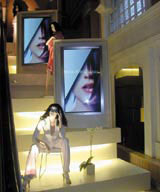Monitor movements
Retailers in all sectors – from prestigious department stores to supermarkets – are using digital screens to inform, seduce and even distract their customers. Maeve Hosea tunes in

Down the road at Harvey Nichols, screens are used for arguably more traditional purposes. Films such as Breakfast at Tiffany’s and Starsky and Hutch are played in certain fashion departments, surrounding Harvey Nichols’ fashion conscious audience with iconic – or possibly ironic – fashion references. ‘People are highly image-savvy these days,’ says a Harvey Nichols spokesman. ‘It is the kind of wit and humour our customers expect.’
The key to maximising the potential of screen technology is to keep it simple, believes Nigel Stern, managing director of consultancy Coutts Creative. It created interactive screens to launch Hutchison Telecom’s 3G mobile service 3 last year. ‘We used screens because it was necessary to demonstrate the phone carried a video capacity,’ says Stern. ‘Screens are no more than a moving poster,’ he adds. ‘If you try to use them in a more complex way, they tend to lose value because people don’t have time to stand there.’
Sandy Westwater, global marketing director at solution provider Digital View, agrees, and says interactive digital displays in-store are best used to educate consumers and raise awareness of increasingly complex products and services. ‘They allow time-poor retailers and brands to communicate increasingly complex information quickly in a way that static posters and literature cannot do alone,’ Westwater adds.
L’Oréal uses an interactive screen as part of a display for its Colour Expert hair product. Sitting among the merchandise at point-of-sale, a screen, designed by interactive specialist Retec, is an integral part of a unit designed by IDA. Here, technology is used to demystify the way a beauty product is used. ‘If you saw a box of L’Oréal Colour Expert on the shelf you wouldn’t necessarily take it home,’ says Retec chief executive John Cole. ‘Where you have a complicated product, images on-screen can simplify things.’
Explanations of a more brand-led nature are the core feature of screens used by Co-op stores, designed by ward design in collaboration with Screenplay TV. Across stores in Oxford, Swindon and Gloucester, in-store screens are designed to communicate to customers what the company stands for. In a number of stores, interactive screens are focused on a zone known as The Gallery.
‘We have a bit of a reputation for being innovative,’ claims Bill Laird, group general manager for retail, Oxford, Swindon and Gloucester Co-op. ‘We were one of the first retailers to put a plasma screen TV in the floor. But people were ambivalent about walking on it, so we have suspended them instead.’
Aside from promoting the Co-op and its brand, screens are used to inform on issues such as ethical labelling and fair trade. ‘The project is about communicating all the values that Co-op stands for,’ says John Ward, managing director of Ward Design, which created store concepts from graphics to screens and store environments, all regularly updated by Screenplay TV. ‘The whole thing has moved on and doesn’t look like the traditional Co-op anymore.’
Maeve Hosea is a journalist at Instore
-
Post a comment




